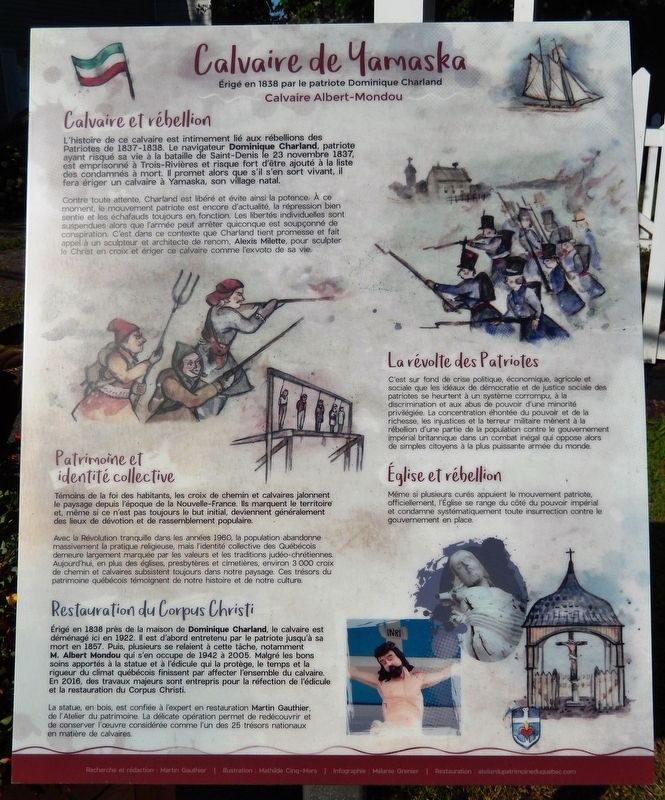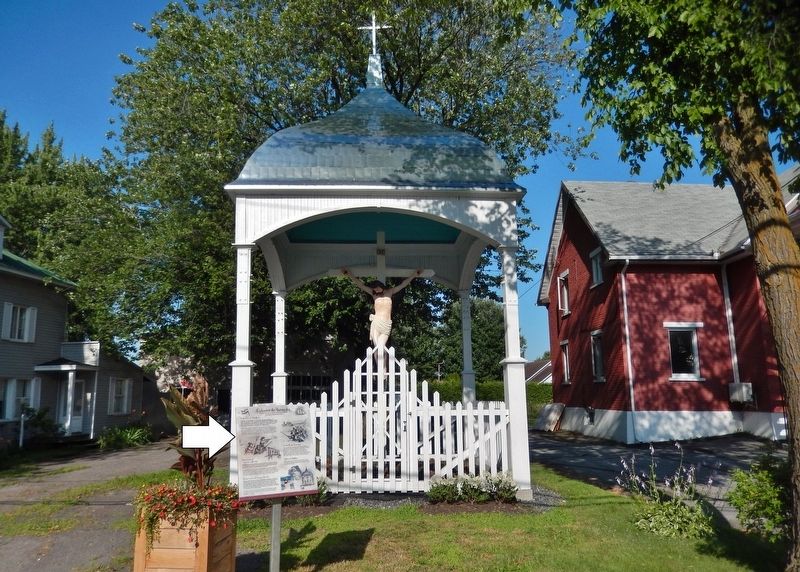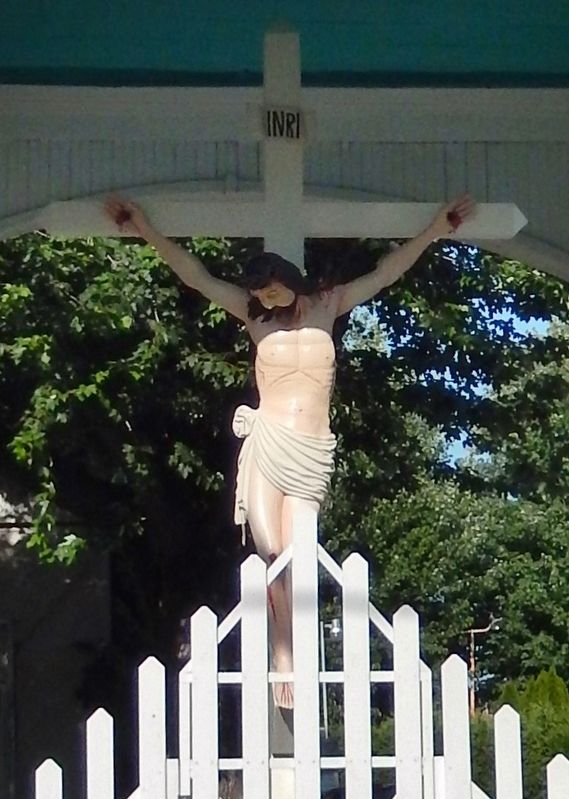Yamaska-Est in Pierre-De Saurel, Québec — Central Canada (French-Canadian)
Calvaire de Yamaska
Érigé en 1838 par le patriote Dominique Charland
— Calvaire Albert-Mondou —
Calvaire et rébellion
L'histoire de ce calvaire est intimement lié aux rébellions des Patriotes de 1837-1838. Le navigateur Dominique Charland, patriote ayant risqué sa vie à la bataille de Saint-Denis le 23 novembre 1837, est emprisonné à Trois-Rivières et risque fort d'être ajouté à la liste des condamnés à mort. Il promet alors que s'il s'en sort vivant, il fera ériger un calvaire à Yamaska, son village natal.
Contre toute attente, Charland est libéré et évite ainsi la potence. À ce moment, le mouvement patriote est encore d'actualité, la répression bien sentie et les échafauds toujours en fonction. Les libertés individuelles sont suspendues alors que l'armée peut arrêter quiconque est soupçonné de conspiration. C'est dans ce contexte que Charland tient promesse et fait appel à un sculpteur et architecte de renom, Alexis Milette, pour sculpter le Christ en croix et ériger ce calvaire comme l'exvoto de sa vie.
Patrimoine et identité collective
Témoins de la foi des habitants, les croix de chemin et calvaires jalonnent le paysage depuis l'époque de la Nouvelle-France. Ils marquent le territoire et, même si ce n'est pas toujours le but initial, deviennent généralement des lieux de dévotion et de rassemblement populaire.
Avec la Révolution tranquille dans les années 1960, la population abandonne massivement la pratique religieuse, mais l'identité collective des Québécois demeure largement marquée par les valeurs et les traditions judéo-chrétiennes. Aujourd'hui, en plus des églises, presbytères et cimetières, environ 3 000 croix de chemin et calvaires subsistent toujours dans notre paysage. Ces trésors du patrimoine québécois témoignent de notre histoire et de notre culture.
Restauration du Corpus Christi
Érigé en 1838 près de la maison de Dominique Charland, le calvaire est déménagé ici en 1922. Il est d'abord entretenu par le patriote jusqu'à sa mort en 1857. Puis, plusieurs se relaient à cette tâche, notamment M. Albert Mondou qui s'en occupe de 1942 à 2005. Malgré les bons soins apportés à la statue et à l'édicule qui la protège, le temps et la rigueur du climat québécois finissent par affecter l'ensemble du calvaire. En 2016, des travaux majeurs sont entrepris pour la réfection de l'édicule et la restauration du Corpus Christi.
La statue, en bois, est confiée à l'expert en restauration Martin Gauthier, de l'Atelier du patrimoine. La délicate opération permet de redécouvrir et de conserver l'œuvre considérée comme l'un des 25 trésors nationaux en matière de calvaires.
La révolte des Patriotes
C'est sur fond de crise politique, économique, agricole et sociale que les idéaux de démocratie et de justice sociale des patriotes se heurtent à un système corrompu, à la discrimination et aux abus de pouvoir d'une minorité privilégiée. La concentration éhontée du pouvoir et de la richesse, les injustices et la terreur militaire mènent à la rébellion d'une partie de la population contre le gouvernement impérial britannique dans un combat inégal qui oppose alors de simples citoyens à la plus puissante armée du monde.
Église, et rébellion
Même si plusieurs curés appuient le mouvement patriote, officiellement, l'Église se range du côté du pouvoir impérial et condamne systématiquement toute insurrection contre le gouvernement en place.
Calvary and Rebellion
The history of this ordeal is intimately linked to the Patriot rebellions of 1837-1838. The navigator Dominique Charland, a patriot who risked his life at the Battle of Saint-Denis on 23 November 1837, was imprisoned in Trois-Rivières and was likely to be added to the list of death row inmates. He then promises that if he makes it out alive, he will have an ordeal erected in Yamaska, his native village.
Against all odds, Charland is released and thus avoids the gallows. At this time, the patriotic movement is still relevant, the repression well felt and the scaffolds still in operation. Individual freedoms are suspended while the army can arrest anyone suspected of conspiracy. It is in this context that Charland keeps promise and calls on a renowned sculptor and architect, Alexis Milette, to sculpt Christ on the cross and erect this ordeal as the ex-voto of his life.
Heritage and Collective Identity
Witnesses to the faith of the inhabitants, the crosses of paths and calvary stake the landscape since the time of New France. They mark the territory and, although this is not always the original purpose, generally become places of devotion and popular gathering.
With the Quiet Revolution in the 1960s, the population abandoned religious practice en masse, but the collective identity of Quebecers remained largely marked by Judeo-Christian values and traditions. Today, in addition to churches, presbyteries and cemeteries, about 3,000 crosses of paths and calvary still remain in our landscape. These treasures of Quebec's heritage bear witness to our history and culture.
Restoration of Corpus Christi
Built in 1838 near the house of Dominique Charland, the ordeal moved here in 1922. It was first maintained by the patriot until his death in 1857. Then, many took turns in this task, including Mr. Albert Mondou, who took care of it from 1942 to 2005. Despite the good care given to the statue and the building that protects it, the weather and the harshness of Quebec's climate end up affecting the whole ordeal. In 2016, major work is undertaken for the renovation of the building and the restoration of the Corpus Christi.
The statue, made of wood, is entrusted to the restoration expert Martin Gauthier of the Heritage Workshop. The delicate operation allows the rediscovery and preservation of the work considered one of the 25 national treasures in terms of ordeals.
The Patriot Revolt
It is against the background of political, economic, agricultural and social crisis that the ideals of democracy and social justice of the patriots are confronted with a corrupt system, discrimination and the abuse of power of a privileged minority. The shameless concentration of power and wealth, injustices and military terror lead to the rebellion of a part of the population against the British imperial government in an unequal struggle that then pits ordinary citizens against the most powerful army of the world.
Church and Rebellion
Although several priests supported the patriotic movement, officially, the Church sided with imperial power and systematically condemned any insurrection against the government of the day.
Topics. This historical marker is listed in these topic lists: Churches & Religion • Colonial Era • Wars, Non-US. A significant historical date for this entry is November 23, 1837.
Location. 46° 0.355′ N, 72° 54.353′ W. Marker is in Yamaska-Est, Québec, in Pierre-De Saurel. Marker is on Rue Centrale (Route 132) just south of Rue du Pont, on the right when traveling north. Touch for map. Marker is at or near this postal address: 164 Rue Centrale, Yamaska-Est QC J0G, Canada. Touch for directions.
Other nearby markers. At least 1 other marker is within 21 kilometers of this marker, measured as the crow flies. Bref Historique du Canon de la Baie-du-Febvre (approx. 20.1 kilometers away).
Credits. This page was last revised on January 23, 2022. It was originally submitted on September 26, 2019, by Cosmos Mariner of Cape Canaveral, Florida. This page has been viewed 206 times since then and 22 times this year. Photos: 1, 2, 3. submitted on September 26, 2019, by Cosmos Mariner of Cape Canaveral, Florida.


